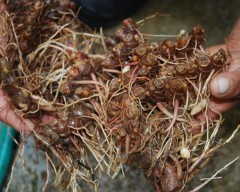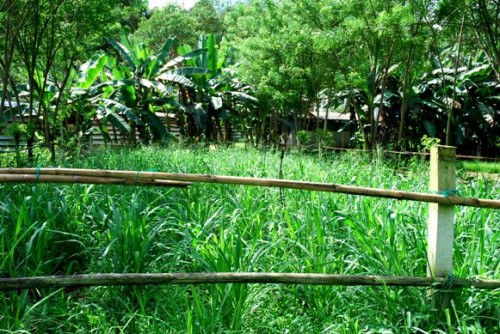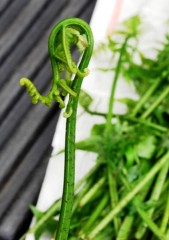Mar 14, 2011
Permaculture At The Farm I
Here's some permanent agriculture (permaculture) features at the farm:
Alley cropping of napia grasses to reduce pressure on arable land for ruminants. By cultivating grasses we can raise up to 200 goats per acre of land versus around 15 here in Malaysia. We alley crop with nitrogen-fixing leguminous gliricidia septum. It may be necessary to fallow with leguminous cover crops after a couple of years. At the moment, we ferment chicken discards such as feathers, guts, etc. to produce a liquid fertiliser, and fertilise twice a year. So far, production of grass has been maintained, a good example of sustainability.

Passion (fruit) vines grow fast, and produce sufficient foliage to impart noticeable cooling. Sun-shading using plants is efficient, easy, with little maintenance needed, and have practically no running costs. Next, passiflora shades in the chicken fields; side effects - more insects and vitamin Cs for the chickens!

Earth drains permit infiltration of water and generally slows down run-offs. However, in our heavy monsoon downpours, earth drains need regular maintenance and may contribute to erosion.
A judicious mix of earth and concrete drains may be necessary, in addition to other water retention and diversion strategies.
Earth drains increase available planting spaces in small farms. Earth drains at our farm are income generating, producing a variety of crops - watercress, edible ferns, pandan leaves, arrowroots, and various edible taro tubers.
The picture shows the laying of low stone barriers across earth drains to slow down water flow and hence reducing erosion. They also allow for deeper, slower flowing sections enabling feeding and hence increasing the population of wild eels which are harvested.

Shaping of land to create catchment areas to retain water, to slow down flow of rain water, and in the case in this picture, to reduce water-logged areas. In the process planting spaces are created for growing water loving vegetables - here, just planted watercress and arrowroot.
After a down pour, the land used to get soggy and difficult to work for days. With these catchment areas, the soggy areas are gone and the catchment area retains water for weeks (due to high water table) - good for planting income generating water loving vegetables.
12:03 Posted in Permaculture | Permalink | Comments (2) | Tags: permaculture, napia grass, sustainable agriculture, organic farming, natural sun-shading, passion fruits, swales, earth drains, retention ponds
Mar 11, 2011
Organic Watermelon At Fine
Officers from FAMA say we are the only organic watermelon producer in the country. They should know, since they visit almost all farms in Malaysia in efforts to upgrade farming methods to meet international marketing requirements.
We sell our watermelon at only one shop, Fine Organic Gallery at No. 103, Jalan Aminuddin Baki, Taman Tun Dr. Ismail, 60000 Kuala Lumpur.
The owner is Mr. Ng (picture below), and the phone number is 03 7727 6044
Here's his shop:
watermelon on raised beds made of old tires
We collect thrown plastic bottles to use to protect young watermelon seedlings
Proud farmer, Pak Cik Razaly, manager at the farm
Here are our previous posts on how we grow our watermelon:
16:36 Posted in Blog | Permalink | Comments (0) | Tags: fine organic gallery, organic watermelon, raised beds
Feb 23, 2011
Home Organic Vegetable Growing
One of our passion is to teach people to grow chemical free vegetables at home; yes, in your terrace link house smack in the heart of P.J. or Subang Jaya.
Recently we held an 8 hour home organic vegetable gardening course for U3A students over 4 weekends during their second semester for 2010. U3A is located at Universiti Putra Malaysia.
We roped in Wong Tar Huei (TH), an Electrical Engineer by training but an organic gardening enthusiast for the past 12 years.
These are pictures of vegetables that TH have grown in his corner link house in P.J. whenever he has spare time and during weekends:
Cauliflower
Making use of free vertical spaces - the fence, to grow bitter gourd
Pumpkins
Cabbages in pots
Close up of home-grown cabbage, grown in a pot
TH sharing his experiences
Section of the class
40 U3A students signed up for the course.
15:46 Posted in Blog | Permalink | Comments (1) | Tags: u3a, life long learning, university of the third age, u3a malaysia, home organic gardening, micro farm at home, organic gardening
Feb 17, 2011
Four Year Old Lempoyang ( zingiber zerumbet )
These are four to five year old lempoyang from our farm. You can call Suria if you wish to purchase them:
Farm manager, Haji Razaly with a bunch of 4 year old lempoyang rhizomes
Younger rhizomes (above picture) similar to those sold in the markets are used by us for replanting. Older rhizomes are used by us for health supplementation purposes.
Here's a research paper on the anti-inflammatory effect of lempoyang :
http://www.ukm.my/rsenr3/rsenr1/P516-520.pdf
The aqueous extract is as effective as reference NSAIDs.
We use the lempoyang as part of our anti-inflammation diet at a dosage of 5 to 10 grams twice a week.
Here's a Bernama report on the effects of lempoyang on cervical cancer:
http://web3.bernama.com/education/newsr.php?id=557690
Readers of this blog please note that the report refers to laboratory results on laboratory animals. Results on humans may differ significantly. Extracts from many plants of the ginger family have been found to have cytotoxic effects on cancer cells in the laboratory but these does not necessarily translate to a cure.
17:35 Posted in Useful Plants | Permalink | Comments (2) | Tags: lempoyang, zingiber zerumbet, cervical cancer
Jan 31, 2011
Starting Free Range Chickens in Malaysia
Fixed houses (reban) where the chickens come out to range and go back in at night is not a good solution to free-ranging slow growing breeds in our wet, humid climate. As the chickens can take up to 100 days to reach marketable size, the area around the house would be foul in no time.
The solution is a movable tent, and fenced fields to keep moving the chickens onto fresh grounds.
These are how the fields look like in our farm:
These are the steps:
1. Fence up the area:
To save costs, make your own concrete posts. If you don't know how, learn. It's a skill worth learning. Wooden posts in Malaysia means cutting of jungle trees, termite problems, wood rot, etc. Concrete the bottom of the fence to keep out pigs. You can lose up to 30 chickens per night from a small family of pigs.
2. Make your own field feeders and drinkers:
You can't be a farmer without basic bar-bending and welding skills.
3. Have a stationary seine-net like area for catching the chickens:
We generally can have an area up and running for 1000 chickens within 10 days - two hoop houses, 30 field feeders, water tank and self-made line drinkers, and fencing and posts for an area that's equal to half an acre ( the grass will last about 20 days, then you have to shift the chickens to the next field. If you don't, the chickens will start having health problems).
14:51 Posted in Chickens | Permalink | Comments (4) | Tags: hoop houses, pastured poultry system, free-range chicken, organic chicken, ayam kampung
Jan 27, 2011
Kunyit Hitam - We hit a mother lode
We hit upon a clump of withered curcuma plants with dried yellow leaves, in the forest next to the farm. This is what we pulled out from underneath the plants; easily a kilogram :

Close up with one of the rhizomes sliced opened.
click for close up
This is how you propagate the black kunyit fast. Remove the rhizomes that extend down into the soil to use, and split those above to plant.
NOTE 22/7/2012 : TWO READERS OF THIS BLOG, ONE FROM HAWAII, AND ANOTHER FROM LANGKAWI, PAK DIN, http://herbwalk-langkawi.com.my/thewalk.html HAVE IDENTIFIED THIS PLANT AS Kaempferia parviflora, A PLANT FOUND IN NORTHERN THAILAND AND USED EXTENSIVELY FOR TRADITIONAL MEDICINE. THANKS TO BOTH FOR HELPING OUT.
THE PLANT WAS FOUND IN A FOREST NEXT TO OUR FARM. WE TAKE NOTE THAT THE FOREST IN QUESTION IS BOUNDED ON THREE SIDES BY FARMS AND ON ONE SIDE BY A FOREST RESERVE. WE CAN ONLY SPECULATE HOW IT WAS INTRODUCED INTO THE FOREST, THOUGH WE MUST ADMIT IT SEEMS EXTREMELY WELL ADAPTED TO THE CONDITIONS LOCALLY AND WE HAVE NEVER SEEN ANY DISEASE AFFECTING THE SAID PLANT.
19:18 Posted in Useful Plants | Permalink | Comments (5) | Tags: black turmeric, kunyit hitam, temu hitam, kali haldi, curcuma aeruginosa, curcuma caesia
Jan 17, 2011
Sweet Potatoes for the beginner organic farmer
Sweet potatoes are ideal for the beginning organic farmer and the beginning permaculturist. It is an undemanding crop and do not require high nitrogen inputs ( which equal to less costs and less disease problems).
If you are trying to earn some extra cash, then grow the purple colored varieties as they fetch a higher price and is always in demand (because of its higher antioxidant content). Organic shops will buy them off you anytime.
To grow them, start a nursery with tubers ( of the quality and variety you want ) as follows:
This one uses a conventional black nursery poly bag.
Here we use discarded tyres from tyre shops at no costs.
Instead of a nursery, you can also use cuttings from fully grown vines from existing sweet potatoe patches (so long as you know the quality).
When the shoots or slips, as they are called, are about 8 inches long, snip them off and plant to soil.
The slip is snip off to plant. The tuber will continue to provide slips for months.
Snip off the lower leaves before planting.
Bunch of slips
Insert the slip into the soil at an angle using a bamboo or a piece of wood.
A planted bed.
Raised beds are preferred. Use sandy soil. Do not fertilise with high nitrogen fertilisers such as chicken dung. Use vermicast, compost or humus. Sweet potato is ready for harvest in 4 months (depending on variety).
The home gardener or small-scale farmer can start a nursery in one tyre and then plant individual slips in seperate tyres as follows:
Planting in tyres as raised beds to make use of land with bad clayey soil at the farm (click on pic for close up)
Each tyre will then produce one crop of sweet potatoes and you harvest as and when you need them.
At our farm, we also plant sweet potatoe as a living mulch:
10:38 Posted in Permaculture | Permalink | Comments (0) | Tags: sweet potato, ipomoea batatas, purple sweet potato, slips
Jan 10, 2011
Edible Ferns
Edible ferns have been enjoyed for thousands of years by rural folks. It is now making its way into gourmet restaurants and urban kitchens. If your farm have earth drains, then edible ferns can be an extra source of income with almost zero costs. Just make sure that your water source is pristine as ferns are good absorbers of heavy metals.
This one, diplazium esculentum
Not this one. Note the difference in the branching.
Edible fronds and young leaves.
Edible fronds
Edible ferns are delicious stir-fried with sambal belacan, or just dried anchovies, or plain garlic.
09:43 Posted in Permaculture | Permalink | Comments (2) | Tags: edible ferns, paku pakis, pucuk paku, diplazium esculentum, fiddleheads
Jan 03, 2011
Non-Paying lover of our chickens came visiting....
The way to handle them is to bundle them in a sack and release them far, far away....
16 footer, 90 pounder (40kg) being manhandled by bouncers from Nepal.
10:17 Posted in Blog | Permalink | Comments (0) | Tags: chicken predators, python, pythonidae, snakes
Dec 29, 2010
Malaysia's Best Durians?
We have received our Malaysia's Best certification from FAMA. This means that the country's national marketing authority for agricultural produce have satisfied themselves that we have met all national and international good agricultural practices.
We remain the ONLY certified organic durian farm in the country. There's this guy selling 'organic' durians from Pahang at Bangsar in front of TMC. It is not from our farm, be warned!

If we do sell our durians locally, it will be with a SOM sticker and a copy of the FAMA certificate or the organic certificate (SOM certificate) below:

10:14 Posted in Blog | Permalink | Comments (0) | Tags: fama, som, certification, sijil organik malaysia, malaysia's best, gap, salm, organic certification in malaysia, organic durians






















































